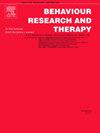Psychological mechanisms of change in reducing co-occurring social anxiety and alcohol use: A causal mediation analysis of the online Inroads intervention
IF 4.5
2区 心理学
Q1 PSYCHOLOGY, CLINICAL
引用次数: 0
Abstract
Background
Research has documented the prevalence and treatment of co-occurring anxiety and alcohol use, but the mechanisms underlying treatment efficacy, especially in online interventions, remain unclear. This study investigated the potential behavioral, cognitive, and motivational mechanisms mediating the effectiveness of ‘Inroads,’ the first online early intervention for co-occurring anxiety and hazardous alcohol use in young adults.
Methods
Data from an Australian randomized controlled trial with 123 participants aged 17–24 (M = 21.6) was used. Causal multiple mediation analysis tested whether improvements in social anxiety symptoms could jointly be attributable to reductions in maladaptive emotion regulation and alcohol use, and whether reductions in alcohol use (mean drinks per day) could jointly be attributable to reductions in maladaptive emotion regulation, alcohol motives (drinking to cope with anxiety and for enhancement), and alcohol outcome expectancies (tension reduction and social lubrication).
Results
The results did not support a joint mediated effect for the hypothesized mechanisms in the social anxiety or alcohol use model.
Conclusions
Additional research is required to further understand the specific mechanisms, driving reductions in social anxiety and alcohol use within integrated treatments. This is especially true for social anxiety where, there was no evidence to suggest that the hypothesized mediators contributed to change in social anxiety symptoms.
减少同时发生的社交焦虑和酒精使用的心理机制变化:在线入侵干预的因果中介分析
研究已经记录了同时发生的焦虑和酒精使用的患病率和治疗,但治疗效果的潜在机制,特别是在线干预,仍然不清楚。这项研究调查了潜在的行为、认知和动机机制,这些机制介导了“侵入”的有效性,这是第一个针对年轻人同时出现的焦虑和危险酒精使用的在线早期干预。方法采用澳大利亚一项随机对照试验的数据,共有123名17-24岁的参与者(M = 21.6)。因果多重中介分析测试了社交焦虑症状的改善是否可以共同归因于适应不良情绪调节和酒精使用的减少,以及酒精使用(每天平均饮酒量)的减少是否可以共同归因于适应不良情绪调节、饮酒动机(饮酒以应对焦虑和增强)和酒精结果预期(紧张缓解和社会润滑)的减少。结果结果不支持社交焦虑或酒精使用模型中假设机制的联合介导效应。结论:需要进一步的研究来进一步了解具体机制,在综合治疗中减少社交焦虑和酒精使用。对于社交焦虑来说尤其如此,没有证据表明假设的介质有助于社交焦虑症状的改变。
本文章由计算机程序翻译,如有差异,请以英文原文为准。
求助全文
约1分钟内获得全文
求助全文
来源期刊

Behaviour Research and Therapy
PSYCHOLOGY, CLINICAL-
CiteScore
7.50
自引率
7.30%
发文量
148
期刊介绍:
The major focus of Behaviour Research and Therapy is an experimental psychopathology approach to understanding emotional and behavioral disorders and their prevention and treatment, using cognitive, behavioral, and psychophysiological (including neural) methods and models. This includes laboratory-based experimental studies with healthy, at risk and subclinical individuals that inform clinical application as well as studies with clinically severe samples. The following types of submissions are encouraged: theoretical reviews of mechanisms that contribute to psychopathology and that offer new treatment targets; tests of novel, mechanistically focused psychological interventions, especially ones that include theory-driven or experimentally-derived predictors, moderators and mediators; and innovations in dissemination and implementation of evidence-based practices into clinical practice in psychology and associated fields, especially those that target underlying mechanisms or focus on novel approaches to treatment delivery. In addition to traditional psychological disorders, the scope of the journal includes behavioural medicine (e.g., chronic pain). The journal will not consider manuscripts dealing primarily with measurement, psychometric analyses, and personality assessment.
 求助内容:
求助内容: 应助结果提醒方式:
应助结果提醒方式:


